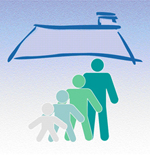Having a regular medical doctor, 2009
Archived Content
Information identified as archived is provided for reference, research or recordkeeping purposes. It is not subject to the Government of Canada Web Standards and has not been altered or updated since it was archived. Please "contact us" to request a format other than those available.

For many Canadians, the first point of contact for medical care is their doctor. Being without a regular medical doctor is associated with fewer visits to general practitioners or specialists, who can play a role in early screening and treating of medical conditions. Over the past decade, the percentage of Canadians reporting having a regular medical doctor has declined.
In 2009, 84.9% of Canadians aged 12 and older reported having a regular medical doctor. The overall percentage of people having a regular medical doctor has declined since 2003, but the gap between the sexes has remained relatively stable (Chart 1).
Chart 1
Percentage with regular medical doctor, by sex, household population aged 12 and older, Canada, 2003 to 2009

Source: Canadian Community Health Survey, 2003, 2005, 2007, 2008 and 2009.
In 2009, men in all age groups except 12 to 19 were significantly more likely than women to report being without a regular doctor. The largest difference between the sexes was in the 20–to–34 age group, in which 33.1% of men, and 18.6% of women, were without a doctor, and the 35–to–44 age group, in which 23.9% of men, and 11.5% of women, were without a doctor. Starting at age 20, the difference between the sexes decreased as age increased (Chart 2).
Chart 2
Percentage without regular medical doctor, by age group and sex, household population aged 12 and older, Canada 2009

Source: Canadian Community Health Survey, 2009.
Rates of access to a regular doctor were above the national average in Prince Edward Island, Nova Scotia, New Brunswick, Ontario and British Columbia. Most other provinces and territories were below the national average, except Newfoundland and Labrador, Manitoba and Saskatchewan, which were at the national average.
In 2009, the most common reason respondents gave for not having a regular doctor was that they had not looked for one (54.0%). Another, 44.0%, or nearly 1.9 million people, reported that they could not find a doctor—no doctors were available in their area, doctors in the area were not taking new patients, or their doctor had left or retired. The proportion who could not find a doctor was stable from 2008 to 2009, but rose from 2003 to 2008.
Of the 4.3 million Canadians without a regular doctor in 2009, 81.6% reported having a place that they usually went to when ill or in need of health advice. When they needed medical care, 60.8% reported using a walk-in clinic, unchanged since 2008; another 13.1% visited a hospital emergency room, down from 14.9% in 2008; 9.4% used a community health centre or, in Quebec, a centre local de services communautaires, also the same share as in 2008. The remaining 18.4% of those with no regular doctor had no usual place for advice on health matters.
References
Nabalamba, Alice and Wayne Millar. 2007. "Going to the doctor." Health Reports, 18(1): 23–35. /pub/82-003-x/2006002/article/doctor-medecin/9569-eng.pdf (accessed May 10, 2010)
Carrière, Gisèle. 2005. "Consultations with doctors and nurses." Health Reports, 16(4): 45–48. /studies-etudes/82-003/archive/2005/8043-eng.pdf (accessed May 10, 2010)
Tjepkema, Michael. 2008. "Health care use among gay, lesbian and bisexual Canadians." Health Reports, 19(1): 53–64. /pub/82-003-x/2008001/article/10532-eng.pdf (accessed May 10, 2010)
Data
Additional data from the Canadian Community Health Survey are available from CANSIM table 105–0501.
- Date modified:
